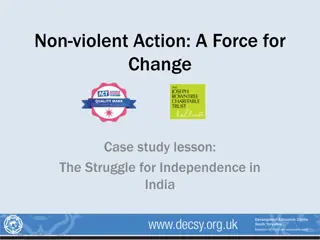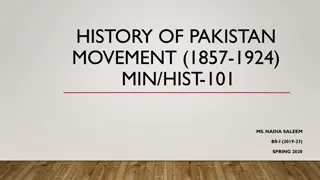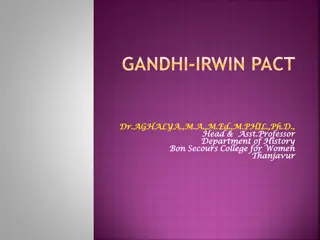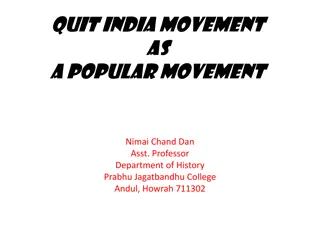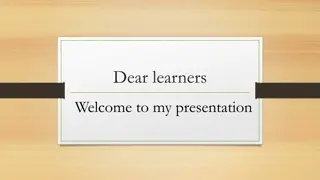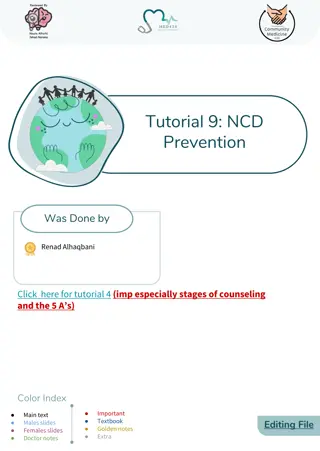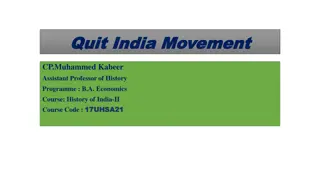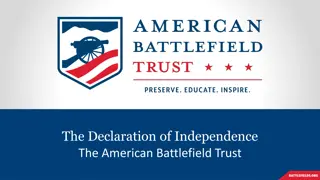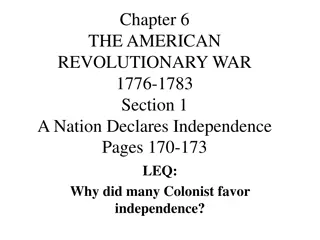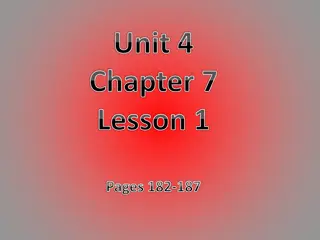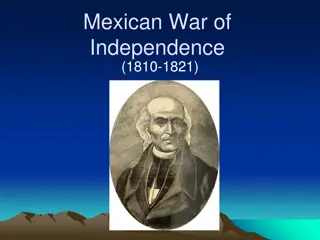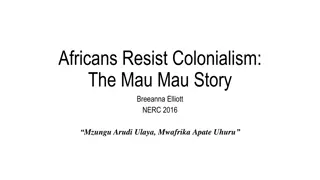The Quit India Movement: A Pivotal Moment in India's Independence Struggle
The Quit India Movement, also known as the India August Movement, was a key event in India's fight for independence led by Mahatma Gandhi in 1942. This movement urged the British to grant India independence through peaceful non-violent protests. It called for an immediate end to British rule, the formation of a provisional Indian government, and unity among various sectors to support the cause. The movement's significance and demands shaped the trajectory of India's independence struggle.
Download Presentation

Please find below an Image/Link to download the presentation.
The content on the website is provided AS IS for your information and personal use only. It may not be sold, licensed, or shared on other websites without obtaining consent from the author. Download presentation by click this link. If you encounter any issues during the download, it is possible that the publisher has removed the file from their server.
E N D
Presentation Transcript
Dr.AGHALYA.,M.A.,M.Ed.,M.PHIL., Dr.AGHALYA.,M.A.,M.Ed.,M.PHIL.,Ph.D Head & Head & Asst.Professor Department of History Department of History Bon Secours College for Women Bon Secours College for Women Ph.D., ., Asst.Professor Thanjavur Thanjavur
Mumbais Gowalia Tank Maidan also known as August Kranti Maidan is the place where the quit India movement was launched by Mahatma Gandhi. He along with other leaders gathered here on August 8 and 9, 1942.
Also known as the India August Movement or August Kranti. It was officially launched by the Indian National Congress (INC) led by Mahatma Gandhi on 9 August 1942. The movement gave the slogans Quit India or Bharat Chodo . Gandhi gave the slogan to the people Do or die . In line with the Congress ideology, it was supposed to be a peaceful non-violent movement aimed at urging the British to grant India independence. The Quit India Resolution was passed by the Congress Working Committee on 8 August 1942 in Bombay. Gandhi was named the movement s leader.
An immediate end to British rule over India. Declaration of the commitment of free India to defend itself against all kinds of imperialism and fascism. Formation of a provisional government of India after British withdrawal. Sanctioning a civil disobedience movement against British rule.
Government servants: do not resign your job but proclaim loyalty to the INC. Soldiers: be with the army but refrain from firing on compatriots. Peasants: pay the agreed-upon rent if the landlords/Zamindars are anti-government; if they are pro-government, do not pay the rent. Students: can leave studies if they are confident enough. Princes: support the people and accept the sovereignty of them. People of the princely states: support the ruler only if he is anti-government; declare themselves as part of the Indian nation.
Why was it launched? The Second World War had started in 1939 and Japan, which was part of the Axis Powers that were opposed to the British in the war were gaining onto the north-eastern frontiers of India. The British had abandoned their territories in South-East Asia and had left their population in the lurch. This act did not garner much faith among the Indian population who had doubts about the British ability to defend India against Axis aggression. Gandhi also believed that if the British left India, Japan would not have enough reason to invade India. Apart from hearing news about British setbacks in the war, the war-time difficulties such as high prices of essential commodities fostered resentment against the British government. The failure of the Cripps Mission to guarantee any kind of a constitutional remedy to India s problems also led to the INC calling for a mass civil disobedience movement.
The British government responded to the call of Gandhi by arresting all major Congress leaders the very next day.Gandhi, Nehru, Patel, etc. were all arrested. This left the movement in the hands of the younger leaders like Jayaprakash Narayan and Ram Manohar Lohia. New leaders like Aruna Asaf Ali emerged out of the vacuum of leadership. Over 100000 people were arrested in connection with this movement. The government resorted to violence in order to quell the agitation. They were mass floggings and lathi charges. Even women and children were not spared. About 10000 people died in police firing in total. There was no communal violence.
The INC was banned. Its leaders were jailed for almost the whole of the war. Gandhi was released on health grounds in 1944. The people responded to Gandhi s call in a major way. However, in the absence of leadership, there were stray incidences of violence and damage to government property. Many buildings were set on fire, electricity lines were cut and communication and transport lines were broken. Some parties did not support the movement. There was opposition from the Muslim League, the Communist Party of India (the government revoked the ban on the party then) and the Hindu Mahasabha. The League was not in favour of the British leaving India without partitioning the country first. In fact, Jinnah asked more Muslims to enlist in the army to fight the war.
The Communist party supported the war waged by the British since they were allied with the Soviet Union. Subhas Chandra Bose, was by this time, organizing the Indian National Army and the Azad Hind government from outside the country. C Rajagopalachari, resigned from the INC since he was not in favour of complete independence. In general, the Indian bureaucracy did not support the Quit India Movement. There were strikes and demonstrations all over the country. Despite the communist group s lack of support to the movement, workers provided support by not working in the factories. In some places, parallel governments were also set up. Example: Ballia, Tamluk, Satara. The chief areas of the movement were UP, Bihar, Maharashtra, Midnapore, and Karnataka. The movement lasted till 1944.
Significance/what it achieved? Despite heavy-handed suppression by the government, the people were unfazed and continued their struggle. Even though the government said that independence could be granted only after the end of the war, the movement drove home the point that India could not be governed without the support of the Indians. The movement placed the demand for complete independence at the top agenda of the freedom movement. Public morale and anti-British sentiment were enhanced.




